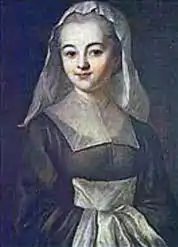
Marguerite Naseau (July 1594 – February 1633)[1] was a French nun and the first member of Daughters of Charity.[2]
Biography
Marguerite Naseau was born in a peasant family in July 1594 in Suresnes.[3][4] She did not have formal education. As a self-taught, she started reading by asking help from the passers-by “in learning letters, words, and pronunciation.” She then taught others including the uneducated girls.[5][6]
In 1630, after she heard the preaching of Vincent de Paul, she approached him to serve in Parisian Confraternity of Charity.[7][8] She later got his permission to provide charitable works in Paris and around for the needy as she did before in her village.[9]
She played important role along with de Paul and Louise de Marillac in transforming the Parisian Confraternity of Charity into a benevolent organization.[3] The works of Daughters of Charity were expanded on a large scale in terms of its size and coverage. Her practical skills such as “cooking and healing expertise” immensely contributed for the advancement of charitable works of Daughters of Charity. This made her as a model for other members in the organization.[10][8]
In February 1633, while working among the plague-stricken in Paris,[11] she died of “plague after sharing a bed with a sick girl”.[12]
References
- ↑ Dinan, Susan E. (2006). Women and Poor Relief in Seventeenth-century France: The Early History of the Daughters of Charity. Farnham (United Kingdom): Ashgate Publishing, Ltd. p. ix. ISBN 978-0-754-65553-4. Retrieved 25 May 2022.
- ↑ Diefendorf, Barbara B. (15 July 2004). From Penitence to Charity: Pious Women and the Catholic Reformation in Paris. Oxford: Oxford University Press. p. 213. ISBN 978-0-198-02558-0. Retrieved 25 May 2022.
- 1 2 O'Donnell, Catherine (15 September 2018). Elizabeth Seton: American Saint. Ithaca, New York: Cornell University Press. p. 235. ISBN 978-1-501-72601-9. Retrieved 25 May 2022.
- ↑ Dinan 2006, p. 81.
- ↑ Gillan Muir, Elizabeth (1 January 2019). Women's History of the Christian Church: Two Thousand Years of Female Leadership. Toronto: University of Toronto Press. p. 249. ISBN 978-1-487-59384-1. Retrieved 25 May 2022.
- ↑ McNamara, Jo Ann (1996). Sisters in Arms: Catholic Nuns through Two Millennia. Cambridge: Harvard University Press. p. 482. ISBN 978-0-674-80984-0. Retrieved 25 May 2022.
- ↑ Halvorson, Michael (2008). Defining Community in Early Modern Europe. Farnham (United Kingdom): Ashgate Publishing, Ltd. p. 69. ISBN 978-0-754-66153-5. Retrieved 25 May 2022.
- 1 2 Dinan 2006, p. 41.
- ↑ Meyers, Debra (11 June 2014). Women and Religion in Old and New Worlds. Oxon: Routledge. p. 80. ISBN 978-1-317-72161-1. Retrieved 25 May 2022.
- ↑ Bellitto, Christopher M. (8 April 2016). Reforming the Church before Modernity: Patterns, Problems and Approaches. Oxon: Routledge. p. 202. ISBN 978-1-317-06949-2. Retrieved 25 May 2022.
- ↑ Halvorson 2008, p. 70.
- ↑ Kuuliala, Jenni (22 October 2019). Lived Religion and Everyday Life in Early Modern Hagiographic Material. London: Springer Nature. p. 98. ISBN 978-3-030-15553-7. Retrieved 25 May 2022.